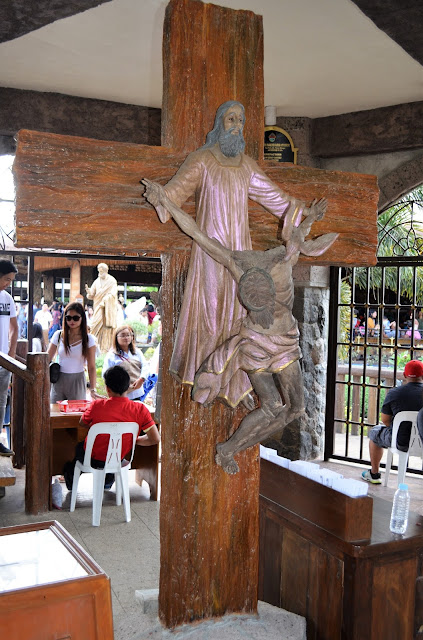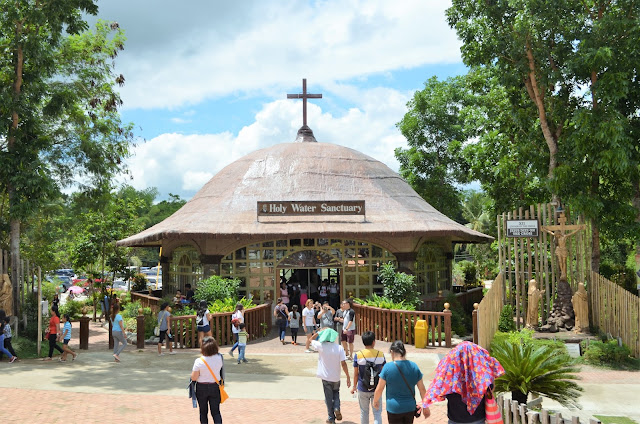It was a beautiful Sunday morning
of May 07, 2017 when I left my house in Imus, Cavite going to Buendia bus
terminal of JAC Liner. I left at exactly 5:00 am and was lucky enough to ride a
bus along Aguinaldo Highway going to Buendia-Ayala route. My destination is my
first visit at the National Shrine of Saint Padre Pio at Sto. Thomas, Batangas.
I arrived at the terminal 6:00 am and ride
a Lucena City bound JAC Liner and ask the bus conductor at the drop point going
to Saint Padre Pio Shrine located at Barangay San Pedro.
I heard many things about the Shrine of Saint
Padre Pio, it’s beautiful domed like church and the Mary Mother of Mercy belfry
which is beside the main church. When I
arrived at the shrine, the church was full of people and pilgrims who will
attend the 8:30 morning mass. I was awed
by the interior of the domed like church wherein the design is in circular and
bamboos are used as the main wall of the altar. The main altar is the crucified
statue of Jesus Christ with the portrait of Saint Padre Pio on the right
side. There are many beautiful spots inside the vicinity of the shrine wherein you can do your selfies or group pictures, but we need to be aware that this is a shrine not a tourist place. This is a place of worship and prayer, devotion, and reflection for us.
The main altar of National Shrine of Saint Padre Pio
Saint Pio of Pietrelcina was an Italian priest, friar, and stigmatist. He is known as the Patron of Civil Defense Volunteers, Adolescents, Pietrelcina, and Stress Relief. His real name is Francesco Forgione. He was known for his piety and charity. He was born on May 25, 1887 and died on September 23, 1968. He was revered as a saint on June 16, 2002 by Saint John Paul II. Saint Padre Pio’s famous quote “Pray, Hope, and Don’t Worry” is his spiritual message to all Christians around the world and directed to put God in all things. Saint Padre Pio is also known to have exhibited the stigmata most of his pious life.
“Stigmata” is a term used by
members of the Christian faith to describe body marks, sores, or sensations of
pain in locations corresponding to the crucifixion wounds of Jesus Christ, such
as the hand, wrists, and feet. (Source: Wikipedia)
Welcome Arc to the Main Shrine wherein the message of Saint Padre Pio is "Pray, Hope, and Don't Worry" is shown.
The Main Church/Shrine of Saint Padre Pio
Beside the main church is the Mary Mother of Mercy belfry
Mary Mother of Mercy Belfry which houses various images and relics of Saint Padre Pio.
Below are some relics and images inside the belfry.
Chapel of Saint Padre Pio (located below the Mary Mother of Mercy belfry)
Wood of the Most Sacred Cross of Our Lord Jesus Christ Sanctuary
Relic of the Holy Cross inside the Sancturary
Saint Padre Pio Paris and Shrine Office
Articoli Religiosi San Giovanni Rotondo (where you can buy religious articles and souvenirs)
Other portion of Articoli Religiosi San Giovanni Rotondo (where you can buy religious articles and souvenirs)
Holy Water Sanctuary
My souvenir photo - Behind Saint Padre Pio statue
Divine Mercy Sanctuary for Pilgrims
Lower view from Mary Mother of Mercy Belfry
Wall dedicated to prayer lock
Mini forest at the lower area of the shrine
Traditional "banga" wherein you can get holy water at the Holy Water Sanctuary
Well maintained garden at the shrine
Statue of an Angel at the entrance of the Shrine
Statue of Sainte Padre Pio inside the Chapel
Breathtaking view of Mount Makiling from the belfry
How to Get There at the National Shrine of Saint Padre Pio
By bus - go to Buendia Terminal (LRT Gil Puyat Station) and take a JAC Liner bus going to Lucena City (Grand Terminal). Tell the bus conductor to drop you at Padre Pio Shrine (Barangay San Pedro), landmark is an overpass where you will drop off (bus fare is 99 pesos). Take a tricycle going to the shrine (fare is 40 pesos if you are alone, 10 pesos each if you are four passengers).






























No comments:
Post a Comment